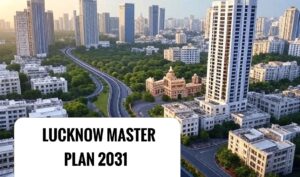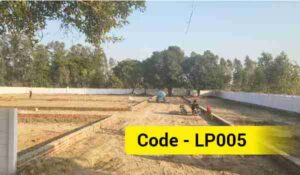Lucknow Master Plan 2031: A Revolutionary Blueprint to Transform the City of Nawabs into a High-Tech Future!
Lucknow, the city of Nawabs, is renowned for its rich culture and historical heritage. However, it is now poised to step into a new era with the Lucknow Master Plan 2031. This ambitious plan not only promises to transform Lucknow into a modern metropolis but also aims to establish it as India’s first AI City. In this detailed and updated blog, we explore the key features, challenges, and future impacts of this master plan.

What is the Lucknow Master Plan 2031?
The Lucknow Master Plan 2031 is a comprehensive urban planning document prepared by the Lucknow Development Authority (LDA) to ensure sustainable and inclusive development of the city by 2031. The plan expands the city’s area to over 71,000 hectares, incorporating more than 197 villages. Its goal is to address the growing population, transportation, housing, and economic needs while preserving the environment and heritage.
Key Features of the Master Plan
The Lucknow Master Plan 2031 proposes several groundbreaking changes to transform the city into a modern and sustainable metropolis. Here are its key highlights:
1. Urbanization and Area Expansion
-
Expansion: The urbanized area of the city will increase from the current 40% to 70%. The total area will cover over 71,000 hectares, including 197 villages integrated into the urban landscape.
-
Modern Infrastructure: Emphasis will be placed on roads, footpaths, drainage, sewerage, and solid waste management systems.
-
GIS-Based Planning: The LDA has developed a GIS (Geographic Information System)-based master plan, making land use, plot details, and information on illegal plotting accessible online. This will help curb land mafias.
2. Residential Development
-
Residential Area: The residential area will expand from 20,578.80 hectares to 30,750.12 hectares (48.06% of the total area).
-
Apartments on Small Plots: Construction of apartments will be permitted on plots as small as 200 square meters, provided the road width is at least 9 meters.
-
Anant Nagar Scheme: Recently launched by the LDA, this scheme will provide over 18,000 flats and thousands of plots for all income groups, particularly targeting economically weaker and low-income sections.
-
Population Target: The plan accounts for an estimated population of 65-80 lakh by 2031, ensuring adequate housing facilities.
3. Transportation and Outer Ring Road
-
104 km Outer Ring Road: This road will connect Kanpur Road, Barabanki-Faizabad Road, Kakori-Hardoi Road, and Sultanpur Road, with an estimated cost of ₹5,000 crore.
-
Relocation of Wholesale Markets: Markets like Aminabad’s medicine market, utensil market, tiles, and grain mandis will be shifted to the outer ring road to reduce traffic congestion in the city’s core.
-
New Bus Terminals and Airport: The plan includes proposals for new bus terminals and a new airport to enhance Lucknow’s connectivity.
-
Chitrakoot Link Expressway: A 15.17 km, 4-lane expressway is planned for development.
4. Commercial and Industrial Development
-
Commercial Area: 1,991.18 hectares are designated for commercial use.
-
AI City: A 1,600-acre AI City on Sultanpur Road, costing ₹10,732 crore, will be India’s first, aligning with the IndiaAI Mission. It is expected to attract 67% more investment than any other tech infrastructure in India.
-
Education City: A 750-acre advanced education hub is proposed on Mohan Road.
-
Wellness City: A 1,350-acre wellness city, including super-specialty hospitals, yoga centers, and a medicine market, is planned.
-
Theme-Based Markets: Theme-based markets will be developed along Kisan Path.
5. Environment and Heritage Preservation
-
Green Corridors: The plan focuses on preserving and developing green areas and water bodies.
-
Tourism and Heritage: Lucknow’s Nawabi and British-era structures will be conserved while revitalizing tourism zones.
-
Solid Waste Management: Emphasis is placed on strengthening waste management and sewerage systems.
6. Four Mega Townships
-
Four new mega townships will be developed, combining residential, commercial, and recreational facilities.
Read More…
- Uttar Pradesh Building Construction and Development By-Laws 2025
- Laws Governing the Sale of Land by Scheduled Caste Landowners to General Category in Uttar Pradesh
- Understanding Section 80 (Section 143) of the Uttar Pradesh Revenue Code, 2006
- Succession Laws in Uttar Pradesh
- 12 Years of Possession (Adverse Possession) and the Property is Yours? The Complete Story of the Limitation Act and Supreme Court Rulings!
- Land Acquisition Act 2013: The Real Story of Farmers’ Rights!
Current Status of the Master Plan
-
Draft Approval: The draft of the Master Plan 2031 has been prepared and approved by the government. In 2023, a government committee instructed revisions on certain points, which have been addressed.
-
Public Consultation: The LDA sought suggestions and objections from the public until October 14, 2022, incorporating them into the final plan.
-
Online Portal: The LDA is set to launch an updated portal on August 15, 2025, to streamline access to master plan details and other services.
-
GIS System: The GIS-based master plan will be available online, enabling citizens to check land use and legality.
Challenges and Criticisms
-
Traffic and Planning: Some residents feel that Lucknow’s roads and traffic management remain inadequate. Social media posts on platforms like X have raised concerns about “smart city” inefficiencies, such as long detours for short distances.
-
Illegal Plotting: Over 46,000 people in Lucknow have fallen victim to illegal plotting. The GIS-based master plan aims to address this issue.
-
Need for Revisions: The government committee highlighted deficiencies, such as no-construction zones and inadequate parking areas, which require correction.
The Future of Lucknow Master Plan 2031
The Lucknow Master Plan 2031 will not only meet the city’s infrastructure needs but also establish it as a technological and economic hub. Projects like India’s first AI City, the outer ring road, and mega townships will position Lucknow as a global destination. Simultaneously, environmental conservation and heritage preservation will ensure the city retains its historical identity.
Download the Master Plan PDF
To download the Lucknow Master Plan 2031 PDF:
-
Visit the official website www.ldaonline.co.in.
-
Navigate to the Downloads section and select “Lucknow Master Plan 2031.”
-
Follow the instructions to download the PDF.
Conclusion
The Lucknow Master Plan 2031 is steering the city of Nawabs toward a high-tech, sustainable, and inclusive future. This plan not only promises a better quality of life for Lucknow’s residents but also has the potential to establish it as one of India’s most modern cities. Are you ready to be part of this transformation? Share your thoughts and spread the word about this revolutionary plan!





















